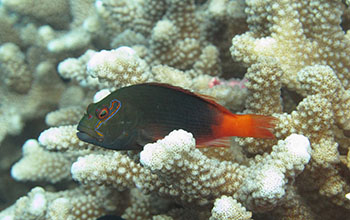搜索结果: 1-15 共查到“海洋生物学 food”相关记录57条 . 查询时间(0.109 秒)

Banks of Antarctica's Ross Sea offer rich food source for emperor penguins(图)
Banks Antarctica Ross Sea rich food source emperor penguins
2020/8/14
A new U.S. National Science Foundation-supported study provides some of the most comprehensive evidence to date of the lengths penguins will go for a meal. The results were reported in the journa...

Diet diversity: Hawkfish species coexist on coral reefs thanks to differing food preferences(图)
Diet diversity Hawkfish species coexist coral reefs food preferences
2020/4/17
How can many species of hawkfish coexist in proximity on the same coral reef? The answer may lie in their individual diets.Hawkfish are brightly colored reef fish that live in tropical oceans. Many re...
Energy Transfer Through Food Webs at Hydrothermal Vents:Linking the Lithosphere to the Biosphere
Energy Transfer Food Webs Hydrothermal Vents Lithosphere Biosphere
2015/7/14
Tectonic and volcanic processes that drive hydrothermal fluid flow and influence its chemistry also regulate the transfer of energy to hydrothermal vent ecosystems. Chemoautotrophic bacteria use the c...
Modeling Food Web Interactions in Benthic Deep-Sea Ecosystems
Deep-Sea Ecosystems Web Interactions
2015/7/3
Deep-sea benthic systems are notoriously difficult to sample. Even more than for other benthic systems, many
flows among biological groups cannot be directly measured, and data sets remain incomplete...
Local climatic changes impact algae living inside the sea ice, which may drastically affect near shore Arctic marine food webs
Scientists traveled to a town near the top of the world to study a creat...
Isotopic invisibility of protozoan trophic steps in marine food webs
A plain Marine food web
2014/10/16
According to modern oceanographic perspectives that emphasize microbial pathways, phagotrophic protists
comprise one to several levels of intermediate consumers between phytoplankton and larger metaz...
A size-structured food-web model for the global ocean
A size-structured food-web model the global ocean
2014/4/2
We present a model of diverse phytoplankton and zooplankton populations embedded in a global ocean circulation model. Physiological and ecological traits of the organisms are constrained by relationsh...
Getting the ‘‘right’’ parameter values for models of the pelagic microbial food web
Getting the rightp arameter values models pelagic microbial food web
2014/4/2
The microbial part of the pelagic food web is believed to be a highly dynamic and tightly coupled network in which system behavior emerges from organism properties and interactions. A central goal in ...
Revealing organic carbon sources fueling a coral reef food web in the Gulf of Mexico using stable isotopes and fatty acids
Revealing organic carbon sources coral reef food web Gulf of Mexico stable isotopes fatty acids
2014/4/2
Carbon and nitrogen stable isotopes and fatty acids (FAs) revealed primary producer organic carbon sources that fuel a coral reef food web with river influence. A stable isotope mixing model was used ...
A size-structured food-web model for the global ocean
A size-structured food-web model the global ocean
2014/4/4
We present a model of diverse phytoplankton and zooplankton populations embedded in a global ocean circulation model. Physiological and ecological traits of the organisms are constrained by relationsh...
The cold-water coral community as a hot spot for carbon cycling on continental margins: A food-web analysis from Rockall Bank (northeast Atlantic)
The cold-water coral community carbon cycling continental margins: A food-web analysis Rockall Bank
2014/4/17
We present a quantitative food-web analysis of the cold-water coral community, i.e., the assembly of living corals, dead coral branches and sediment beneath, associated with the reef-buildingLophelia ...
Tracing abyssal food supply back to upper-ocean processes over a 17-year time series in the northeast Pacific
Tracing abyssal food supply back to upper-ocean processes over a 17-year time series in the northeast Pacific
2014/4/21
Detrital aggregates episodically deposited on the seafloor represent an underestimated food source to deep-sea communities. A 17-yr time-series study was conducted from 1990 to 2006 in the abyssal nor...
Settling blooms of filamentous cyanobacteria as food for meiofauna assemblages
Settling blooms filamentous cyanobacteria as food meiofauna assemblages
2014/4/21
Summer blooms of filamentous nitrogen-fixing cyanobacteria in the Baltic Sea are normally dominated by Aphanizomenon sp. and the toxin-producing Nodularia spumigena. In a 2-week laboratory experiment,...
Living in transparent lakes: Low food P:C ratio decreases antioxidant response to ultraviolet radiation in Daphnia
Living in transparent lakes Low food P:C ratio decreases antioxidant response ultraviolet radiation in Daphnia
2014/4/21
We experimentally tested the effect of food quality (phosphorus [P] : carbon [C] ratio) on the response of antioxidant enzymes to ultraviolet radiation (UVR) in Daphnia commutata fed with Chlamydomona...
Biochemical food quality effects on a Daphnia hybrid complex
Biochemical food quality a Daphnia hybrid complex
2014/4/21
Correlative field studies have shown that the food quality of natural seston for Daphnia is highly correlated with the content of eicosapentaenoic acid (EPA), indicating that the growth of Daphnia in ...

